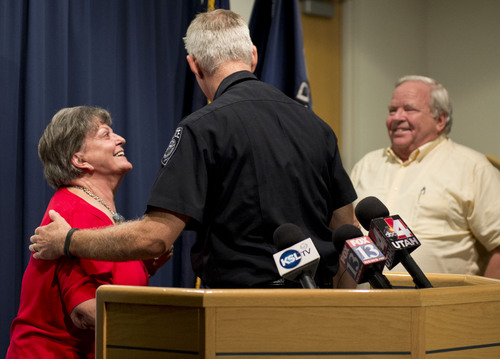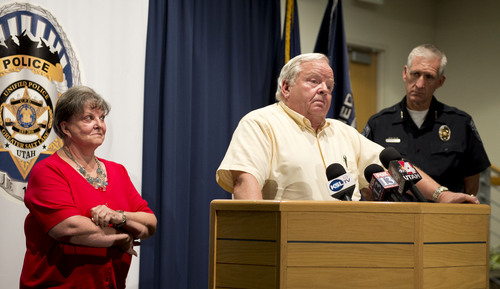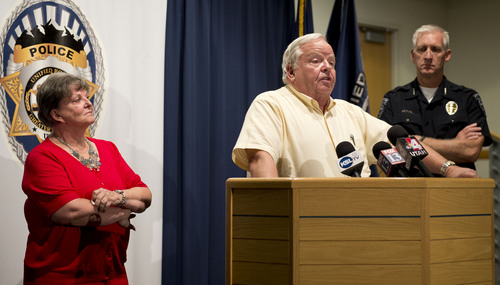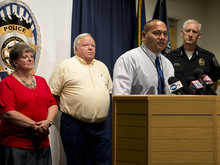This is an archived article that was published on sltrib.com in 2014, and information in the article may be outdated. It is provided only for personal research purposes and may not be reprinted.
Unified Police believe they've solved a Holladay woman's 23-year-old cold case, thanks to DNA and Legos.
DNA testing, fingerprints on Legos found at the crime scene and a recent admission from the suspect's wife led police to pin the 1991 murder of Lucille Johnson on John Sansing. The 47-year-old man is currently on death row in an Arizona prison for an unrelated homicide.
Sansing was charged Thursday in 3rd District Court with aggravated murder. Prosecutors also filed a warrant to bring John Sansing back to Utah, setting his bail at $5 million cash.
"Often times in law enforcement we deal with individuals who can be characterized as not necessarily bad people, but people who do bad things. Occasionally, we run into individuals who are evil," Salt Lake County Sheriff Jim Winder said at a Thursday press conference. Sansing can "only be described as that. This is an individual whose perpetrated crimes are beyond belief."
The last anyone had seen Johnson alive, she had been sweeping her porch on the afternoon of Feb. 1, 1991, according to Unified Police. When her family tried to reach her and couldn't, Johnson's daughter, Shirley England, went to her house at 4284 S. Holloway Drive (1900 East) in Holladay, the next day and found her body.
The 78-year-old woman had died from a blow to the head and strangulation.
During the investigation, officers found Lego toys on her living room floor, in the entryway just inside the home and in the driveway. Detectives learned that she would not have left her grandchildren's toys strewn about her house and collected them as evidence. Detectives also learned that Johnson always wore a particular ring and necklace, both of which were missing.
"Detectives worked very hard on this case, but unfortunately it went cold," according a Unified Police news release.
England began to think the case wouldn't be solved as the years went on. She remembered her mother as a very tender and dear woman who was very energetic.
"She had many years… that we were robbed of," England said Thursday. "Grandchildren she never got to see. And she brought blessings in many people's lives."
England always figured her mother's killer was someone she knew. Despite the missing jewelry, there were no signs of forced entry and the doors were locked at the time England came over, according to UPD.
But as far as investigators can tell, Sansing and Johnson were strangers. Investigators suspect that Sansing left his 5-year-old son to play with his Legos on Johnson's living room floor while he killed her.
Detectives reopened the case last summer, submitting scrapings from under Johnson's fingernails to scan for DNA. Investigators matched the DNA profile to Sansing, according to the release.
Detectives also found fingerprints on the Lego toys that matched Sansing's son's, according to UPD.
On top of that, "Sansing's wife also recently admitted to UPD detectives that Sansing had admitted to her near the time of the 1991 murder that he killed an elderly lady in Holladay City," the release reads.
In addition, Sansing's nephew, Chad Sansing, recently approached detectives and told them that he heard John Sansing and his wife arguing on at least two occasions, and overheard John Sansing's wife "threaten [him], telling him that she was going to tell police that he murdered a lady in Utah," according to the charges filed Thursday.
"I want to tell all those individuals that are out there that have cold cases that have yet to be solved, we will never, ever, ever stop," Winder said. "You commit a crime like this in this community, to our dying days we are going to pursue you, we will hunt you down and we will solve these crimes."
Two years after Johnson died, Sansing pleaded guilty to attempted aggravated assault, a class A misdemeanor, in a separate case, according to a search of Utah court records.
Two years after that, in 1995, Sansing moved to Arizona, where he was convicted of a murder in 1998 and sentenced to death.
In that case, investigators say 41-year-old Elizabeth Calabrese was delivering a basket of food to the Sansings when she was tied up, clubbed, raped and murdered. Her body was found hidden beneath cardboard boxes in the backyard of Sansing's home.
Sansing had called Calabrese's church asking for the charitable food delivery, according to the Arizona Department of Corrections.
"He covered her body with a pile of clothing, then left to trade Ms. Calabrese's jewelry for drugs that he and his wife consumed," according to the corrections department. "Each of the four Sansing children saw Ms. Calabrese's dead body in the home."
Sansing pleaded guilty in 1998 and was sentenced the next year.
A Salt Lake City social worker, Ann Lamphere, told The Arizona Republic in 1998 that John Sansing grew up in a broken home in Alabama, and stayed with his mother when his father moved to Utah.
"She finally gave up on him and shipped him out to his father in 1984," Lamphere told the Republic. "He was a thief and drug addict even at that time, and she couldn't keep him out of juvenile detention."
He met his wife, Kara Sansing, Lamphere's adopted daughter, at a Salt Lake City mall, and they had four children together. Kara Sansing had run away from an abusive home in Bangladesh as a child and wound up in a Calcutta jail.
After marrying John Sansing, Lamphere told the Republic that John Sansing would often beat her.
"In the East Indian culture, the husband is the one in charge, who is always right and can even tell the wife to kill herself," Lamphere told the Republic. "She was definitely of that culture. She wouldn't leave him despite all the abuse."
— The Associated Press contributed to this story.
Twitter: @mikeypanda















